Profitable Pig Breeds For Pig Farming
Unlike most other livestock, pigs have only one main commodity that they produce – their meat. In fact, pork is the most popular meat product in the world. If you are interested in raising pigs for financial gain, it’s important to choose the right pig breed to maximize your profits.
What are the most profitable pig breeds for pig farming? There are hundreds of pig breeds, but if you are focused on profits you will want to turn your attention to the following efficient and prolific meat breeds:
- Berkshire
- Chester White
- Duroc
- Yorkshire
- Landrace
- Poland China
- Hereford
- Hampshire
- Large Black
- Crossbreeds
If you are interested in getting into the pig business, it is important to learn as much as you can about the advantages and disadvantages of each of these profitable breeds. To learn more about what makes each of these pigs a great choice for a high-profit business model, read on for more detailed information.
What Makes A Pig Breed Profitable?
There are a few factors involved in pig profitability, but the two main ones are the rate at which a pig will reach market weight, and how prolifically they breed.
While many pig farmers like to raise slower-growing heritage breeds on their homesteads, for a truly profitable business one should focus on pigs bred for commercial production. These breeds will produce high-quality meat in half (or less) the time that a slower-growing breed will. This is crucial when looking at your bottom line, as you can essentially produce twice as much with a commercial pig breed over a slower-growing heritage pig breed – and with less feeding expense.
It is also worth looking into a breed’s average litter size and mothering abilities. A sustainable operation that includes breeding sows will (sometimes, depending on the operation size) be more profitable in the long run than an operation in which you purchase weaned piglets from someone else.
While most sows prove to be good mothers, litter sizes among breeds can vary greatly. Some breeds will have an average litter size of 5-7 piglets, while other breeds produce 15 or more piglets per pregnancy. The more piglets you are able to grow out, the more profit you should expect to make.
Profitable Pig Breeds
Now that you’re familiar with what you should look for in a profitable pig breed let’s dive deeper into the specific breeds mentioned above to help you pick the one that is best suited for your situation.
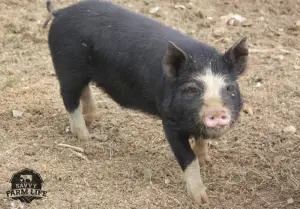
Berkshire Pigs
The profitability of Berkshire pigs brings into focus an additional factor not listed above – quality of meat. Berkshire meat is known to be the “Kobe beef” of the pork industry. It is the most sought-after pork around the world, with a large percentage of US-processed Berkshire pork exported to Japan. Berkshire meat is particularly tender, marbled, and flavorful – and high-quality meat will fetch you high-quality prices.
Berkshires will take approximately 6-6.5 months to reach a market weight, which is quite reasonable in productive breeds. Their average litter size is somewhat smaller than average prolific breeds, at 9 piglets per parity (successful pregnancy).
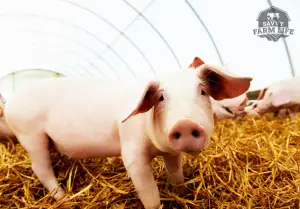
Chester White Pigs
Chester Whites are known as the “mother breed” of pigs. They produce 8-10 piglets per parity on average, are especially attentive to their young, and remain fertile for a higher number of years than many other breeds.
Chester Whites are also fast-growing pigs, finishing to a market weight at approximately 6 months of age.
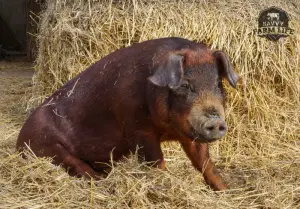
Duroc Pigs
Durocs are the 2nd most popular meat pig raised in the United States, mainly because of their fast growth rate. Duroc pigs reach a market weight at an earlier age than many other breeds, and are therefore commonly used when creating hybrids.
Durocs routinely produce 10-15 piglets per parity, and there are many stories of Duroc sows birthing as many as 24 piglets at a time.
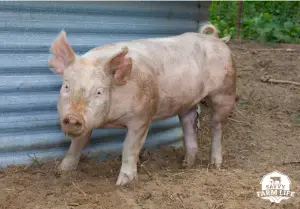
Yorkshire Pigs
The Yorkshire is the most popular meat pig in the United States. While Yorkshire pigs take a bit longer to finish than other breeds – reaching market weight at approximately 10 months of age – they remain popular because of their quality of lean meat.
Yorkshires are prolific breeders, averaging 12-14 piglets per parity, and are excellent mothers. Though anecdotal, it has been said that Yorkshires are less likely to accidentally suffocate their piglets, and take to motherhood easier and more quickly than other breeds.
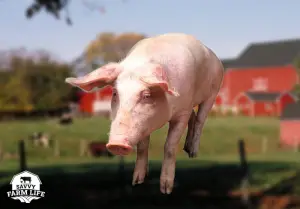
Landrace Pigs
The Landrace is a pig breed noted for its long body – the longest of all breeds. This allows the Landrace to dominate in terms of available back-fat. For this reason, it is known as a “bacon breed”. Because of their body composition, Landraces are commonly used in crossbreeding programs.
Landrace pigs are fast-growing, reaching processing weight by 6 months of age. They have large litters – averaging 14 piglets per parity, and have excellent mothering instincts. Their milk production peaks later than other breeds, and so Landraces will take slightly longer to wean.
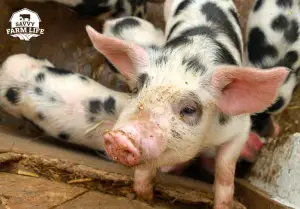
Poland China Pigs
Poland China pigs have been bred over the years to reach a market weight by 6 months of age – similar to that of most of the meat-producing pigs on our list. Poland Chinas typically gain weight easily, on less feed than some other breeds. Of note, the heaviest pig in recorded history, Big Bill, was a Poland China. He weighed over 2,500 pounds.
Poland Chinas are prolific breeders, with average litter sizes into the teens. While earlier Poland Chinas were so heavy that the sows were known to unintentionally crush many of their young piglets, modern Poland Chinas have been bred to mature at a more reasonable weight.
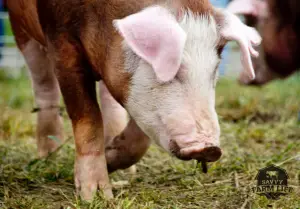
Hereford Pigs
Hereford pigs are excellent meat pigs, but are also popular show hogs within 4H and FFA programs because of their docile dispositions and attractive coloring. This gives you the opportunity to cater to a niche market. Herefords produce average-sized litters, with 8-9 piglets per parity. The sows are good mothers and typically experience few losses.
Hereford pigs are quick to mature, making them a profitable meat breed as well – these pigs typically reach market weight in as little as 5 months.
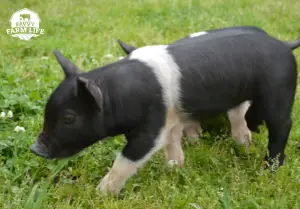
Hampshire Pigs
Hampshire pigs are known for their desirable sires. Boars are commonly used in crossbreeding programs, with the bloodlines providing increased hardiness among piglets and superior carcass composition. Sows of this breed produce between 7 and 15 piglets per parity, and are known to produce piglets into a later age than sows of other breeds.
While Hampshires were once known for reaching market weight too early (undesirable at the time as farmers were not ready to butcher the rest of the herd when Hampshires finished), modern Hampshires are known to finish at a more average pace – between 6 and 7 months of age.
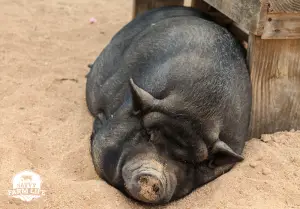
Large Black Pigs
Large Black pigs are slower-growing than some of the other breeds listed, reaching market weight at between 9 and 12 months, but are excellent pasture hogs. This is a heritage breed that can be successfully included in a pasture-raised pork business model.
Large Blacks deliver litters of 8-10 piglets per parity and are known as excellent mothers with high milk yields. They remain productive for as long as 9-10 years, and are known to be hardy in a variety of conditions.
Crossbred Pigs 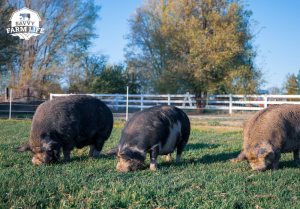
While crossbred pigs are of course not their own breed, they must be mentioned because they are commonly considered most profitable in terms of productivity. To understand why, we must understand the “hybrid vigor” phenomenon. Hybrid vigor refers to the fact that when crossbreeding two purebred animals, the parents’ individual traits are maximized in the offspring. For this reason, crossbred pigs (if using commercial parent breeds) will consistently reach market weight faster than other breeds and on less feed.
Crossbred pigs are becoming more and more popular in commercial operations because of their high productivity. Their litter sizes and mothering capabilities are not worth mentioning, because these traits will vary greatly depending on the parentage. Crossbred pigs are really prized for their hardiness and growth rate.
One of the most popular cross-breeds is called the “Blue Butt”. Blue Butts are bred using a white-line sow such as a Landrace or Chester White and a meat-breed sire such as a Hampshire or a Duroc. These piglets typically have white bodies with gray, spotted rumps.
Something worth mentioning is that hybrid vigor does not affect carcass composition or meat quality. These traits will usually be somewhere in the middle of those belonging to each parent. The benefits of cross-breeding is primarily in growth rate and disease-resistance (hardiness).
Profitability Of Pig Breeds
Pigs are unique in that they can turn a profit for both large and small operations. There isn’t much to it, either – pigs can pretty much take care of themselves so long as they are provided fresh water, feed, and a safe space to roam around. There are many reasons that farmers get into the business of pigs, and if you are reading this, you probably have several of these reasons yourself. If you decide to start with one of the breeds on this list, you will have a good chance at seeing success.
(P.S. Save this article to your “Pig Farming” board on Pinterest!)
